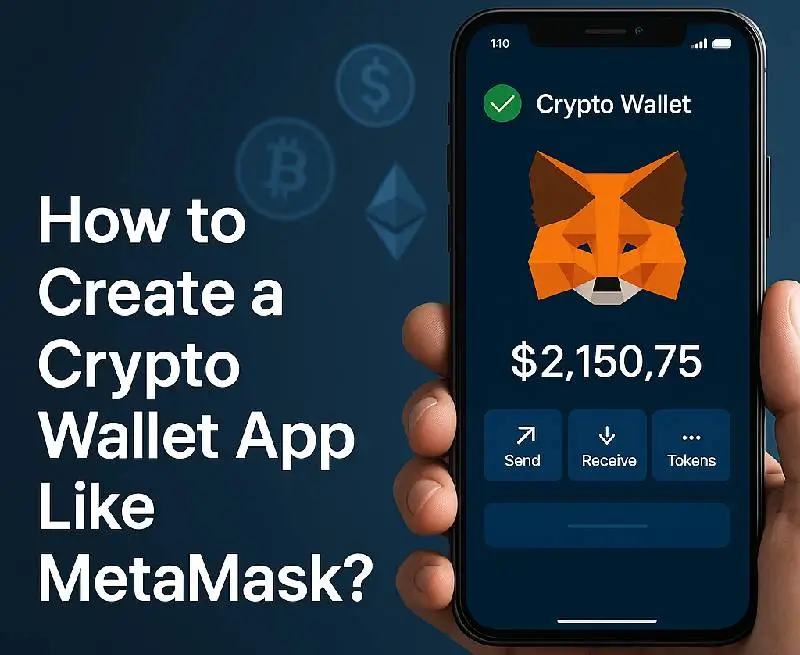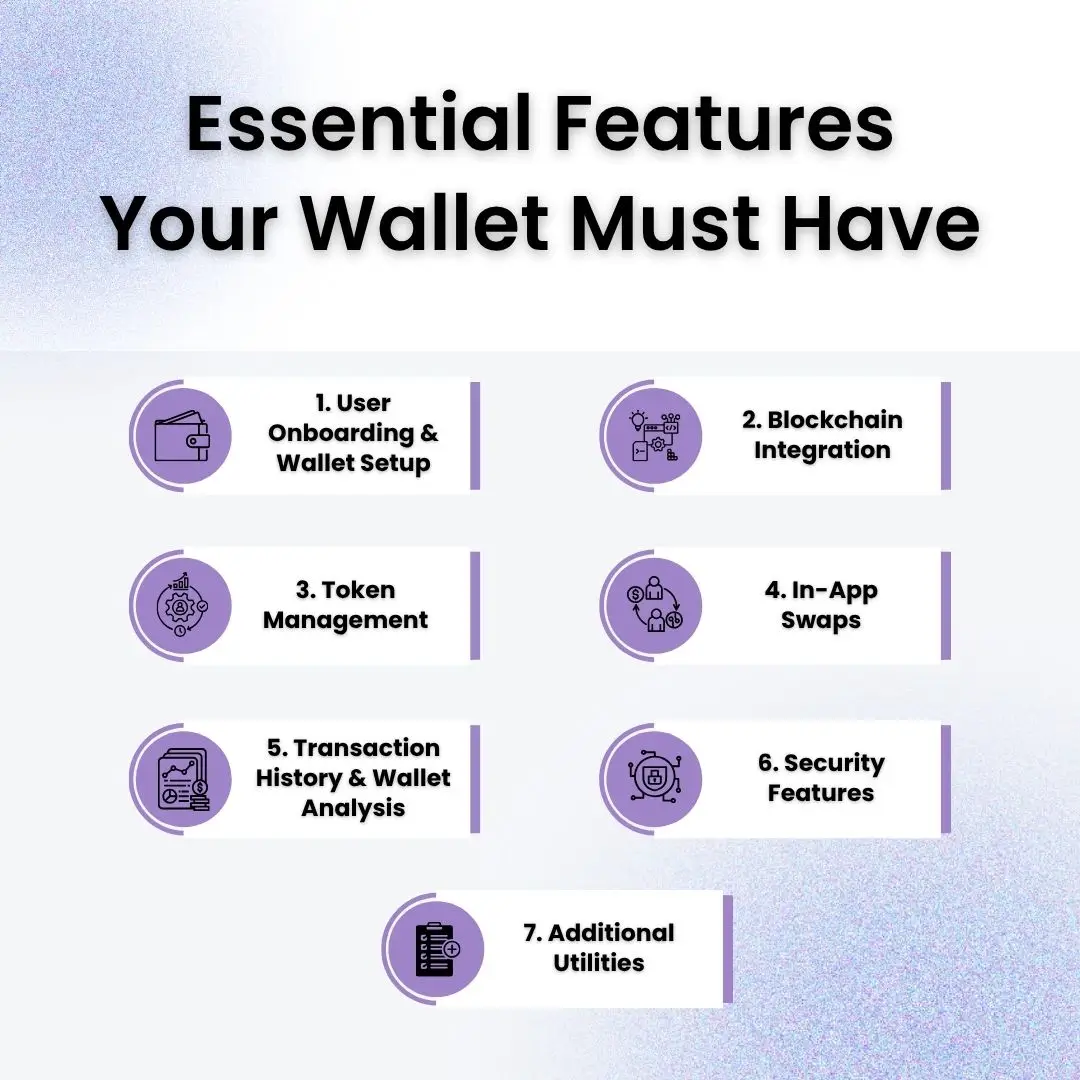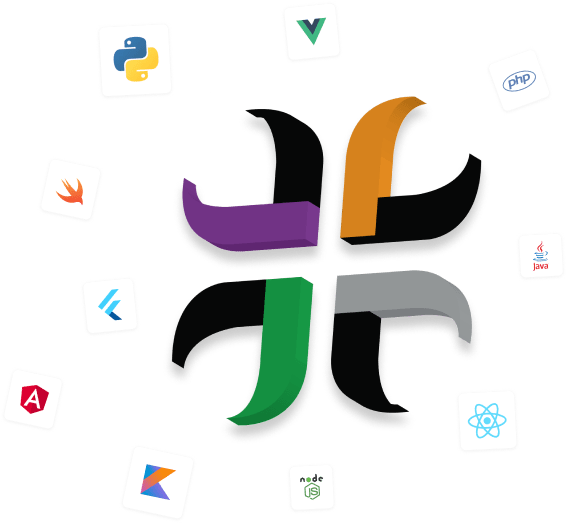
In the decentralized world of cryptocurrencies, self-custody is everything. That’s why crypto wallet apps like MetaMask have become the go-to tools for Web3 users. With the growth of DeFi, NFTs, and smart contract-based ecosystems, secure and user-friendly wallets are in higher demand than ever.
So if you’re wondering how to create a crypto wallet app like MetaMask, you’re in the right place. Whether you’re a startup founder, blockchain product manager, or an enterprise looking to enter the crypto wallet space, this guide will walk you through:
- The types of crypto wallets (hot vs. cold)
- Essential features inspired by MetaMask
- Technologies and frameworks to use
- Blockchain integration methods
- Wallet development cost estimates
- Key compliance and security concerns
- Additional value-added components like swaps, analytics, and gas optimization

Understanding What MetaMask Is
Before you dive into building your own crypto wallet app like MetaMask, it’s crucial to understand what MetaMask is, what makes it so popular, and why users across the world trust it for managing their digital assets.
MetaMask is a non-custodial cryptocurrency wallet that allows users to store, send, and receive digital currencies while maintaining full control over their private keys. “Non-custodial” means MetaMask does not store your keys or assets — the user is solely responsible for safeguarding their wallet. This type of architecture appeals to users who prioritize privacy, security, and independence.
Initially launched in 2016 as a browser extension for Chrome and Firefox, MetaMask was designed to enable seamless access to the Ethereum blockchain. Over the years, it has evolved into a full-fledged digital wallet for cryptocurrency, supporting multi-chain compatibility and offering a host of features that go beyond basic wallet functions.
Today, MetaMask supports leading blockchain networks like:
- Ethereum Mainnet
- Binance Smart Chain (BSC)
- Polygon (Matic)
- Avalanche
- Plus any custom chain wallets added via RPC
This flexibility makes it a go-to tool for users engaging with DeFi platforms, NFT marketplaces, DAO tools, and various Web3 applications.
✅ Why Do Over 30 Million Users Choose MetaMask?
As of 2025, MetaMask boasts over 30 million active users, making it one of the most widely adopted crypto wallets globally. It acts as a bridge between browsers and the blockchain, allowing users to interact directly with decentralized applications (dApps) from within their browser or mobile device.
Here are the core reasons for its popularity:
-
Seed Phrase-Based Wallet Creation
When a new wallet is created in MetaMask, the user is given a 12-word seed phrase (also called a recovery phrase). This acts as the master key to restore or back up the wallet. Because MetaMask is non-custodial, the responsibility of storing this phrase securely lies with the user.
-
Multi-Network Support
MetaMask is not limited to Ethereum. Users can manually add custom RPC networks to access alternative chains like BNB Smart Chain, Avalanche, and even private crypto wallets or testnets for development purposes. This makes MetaMask extremely flexible for users who participate in multi-chain ecosystems or use different platforms.
-
MetaMask Swap
One standout feature is MetaMask Swap, which allows users to swap tokens directly within the app without needing to connect to third-party decentralized exchanges (DEXs). It aggregates quotes from multiple DEXs to offer the best price and minimal slippage. This simplifies crypto trading for users who don’t want to navigate complex DeFi protocols.
-
Web3 Login & dApp Interaction
MetaMask functions as a Web3 gateway, enabling users to log into dApps using their wallet rather than usernames and passwords. This wallet-as-login mechanism is becoming a standard in the decentralized internet and makes interactions with apps like OpenSea, Uniswap, and Aave smooth and secure.
-
Cold Wallet Integrations
MetaMask supports cold storage crypto devices such as Ledger Nano X and Trezor, which let users sign transactions without exposing their private keys online. This added layer of security is especially useful for long-term holders and those managing significant crypto funds.
-
Cross-Device Availability
MetaMask can be used across browsers and mobile devices, including Android and iOS. Users can sync their wallet using QR codes and access their tokens, NFTs, and transaction history anytime, anywhere. The mobile app also supports wallet analysis crypto tools, making it easier to track portfolio value and on-chain activity.
Read More: Build vs Buy Software: Pros, Cons, and Business Use Cases
Types of Cryptocurrency Wallets: Cold vs. Hot vs. Smart Wallets
Before development, decide what type of wallet you want to create:
1. Hot Wallet (like MetaMask)
These are connected to the internet and allow real-time transactions. They’re easy to use but slightly more vulnerable to online threats.
2. Cold Wallet
Cold wallets store crypto assets offline — like hardware wallets or paper wallets. These are more secure and typically used for large-value storage. (Think: Trezor, Ledger)
If you’re wondering what is a cold wallet crypto, it’s essentially the safest way to store crypto — but not ideal for frequent trades.
3. Smart Wallets
These are programmable wallets that use smart contracts for better security and features like recovery, social login, and transaction batching. Think of Argent or Safe (formerly Gnosis Safe).
Knowing your audience and their goals (trading, staking, HODLing, NFTs) will help determine which wallet type you should build.

Essential Features Your Wallet Must Have
When planning how to create a crypto wallet app, think about what users expect from a product like MetaMask. Here’s a list of core features you should include:
1. User Onboarding & Wallet Setup
- Seed phrase generation & backup
- Password-protected login
- Biometric or PIN access (for mobile)
- Option to import existing wallets
2. Blockchain Integration
- Ethereum, BNB Chain, Polygon, Arbitrum
- Custom RPC support for EVM-compatible chains
- Optional integration with blockchain.com wallet or private blockchain nodes
3. Token Management
- Auto token detection
- Manual addition of custom tokens
- NFT support (ERC-721, ERC-1155)
4. In-App Swaps
- Like MetaMask Swap, allow token exchanges via DEX aggregators
- Ensure support for stablecoins, wrapped tokens, and gas optimization
- Display polygon gas fees or Ethereum gas costs before approval
5. Transaction History & Wallet Analysis
- Real-time transaction tracking
- Pending, confirmed, and failed status
- “Running wallet” analytics like wallet balance graphs and token-wise activity logs
6. Security Features
- End-to-end encryption using crypto-js
- Local key storage only (no server-side storage)
- Option to link cold wallets
- Suspicious transaction detection
7. Additional Utilities
- Push notifications for transaction status
- Browser extension and mobile sync
- QR code payments and wallet connect support
Technology Stack to Build a MetaMask-Like App
To build a crypto wallet like MetaMask, you need a robust tech stack that combines frontend excellence, blockchain connectivity, and bulletproof security.
Frontend:
- React.js or Next.js (web app)
- React Native / Flutter (for mobile)
- Tailwind CSS or Material UI for styling
Backend:
- Optional, depending on feature scope (non-custodial wallets don’t need a backend to manage private keys)
- Use Node.js with Express for supporting services (notifications, analytics)
Blockchain Tools:
- web3.js or ethers.js
- Infura, Alchemy, or QuickNode for RPC endpoints
- crypto-js for encryption/decryption
- WalletConnect, Web3Modal, or custom wallet SDKs
Security Libraries:
- bcrypt or argon2 for password hashing
- crypto-js for encryption
- 2FA integration (if required)
Development Steps: From Idea to App Store
Let’s now go through how to create a crypto wallet app, step-by-step:
Step 1: Market & Compliance Research
Understand your user base, jurisdictions, and regulations. Do you need KYC? Is the wallet available in restricted regions? Figure this out early.
Step 2: Define Scope & Features
Create a detailed product roadmap. Will you support multiple chains or start with Ethereum? Will there be MetaMask Swap-like features?
Step 3: Design UI/UX
Design clean, intuitive onboarding, wallet dashboards, and swap interfaces. Security prompts and clarity are key.
Step 4: Start Development
Use agile sprints to develop modules like:
- Wallet setup
- Transaction interface
- Token management
- dApp browser
Step 5: QA & Audits
Run thorough testing — especially on:
- Transaction signing logic
- Gas fee estimation
- Swap integrations
- Smart contract interactions
You May Also Like: How Much Does an App Development Cost in 2025?
Step 6: Launch & Monitor
Submit to Play Store/App Store. Set up crash analytics, usage monitoring, and a clear “how to contact blockchain support” option within the app.
How Much Does Crypto Wallet Development Cost?
The crypto wallet development cost depends on the wallet type, features, team size, and tech integrations.
| Component | Estimated Cost (USD) |
| MVP Wallet App (Single Chain) | $35,000 – $50,000 |
| Multi-Chain Wallet | $60,000 – $100,000 |
| With Swap, NFTs, Analytics | $120,000+ |
| Smart Contract Audits | $5,000 – $15,000 |
| Ongoing Maintenance (monthly) | $2,000 – $8,000 |
If you’re hiring freelancers, the average hourly consulting rate for blockchain devs ranges from $60–$150/hr depending on experience.
Monetization Strategies for Crypto Wallets
Wallets don’t just help users — they can also become profitable products. Here’s how MetaMask and others make money:
- Swap fees (MetaMask Swap charges ~0.875%)
- Partnership revenue with DeFi protocols
- Analytics subscriptions
- Premium features (cold wallet syncing, watch-only mode)
You can also partner with NFT marketplaces, DEXs, or staking providers for commission-based models.
Real-World Challenges in Wallet Development
While the idea sounds exciting, wallet development brings its own challenges:
- Security: Wallets are hot targets. Even a small flaw can lead to fund loss.
- User Error Prevention: Seed phrase handling, gas fees, wrong transactions — users make mistakes. Your UX needs to prevent them.
- Chain Updates: Constant EVM upgrades and gas logic changes require you to keep updating. (Many users search for “update MetaMask” for this reason.)
- Regulations: Crypto regulations differ across regions. You may need compliance experts for global operations.

Bonus Features That Add Value in 2025
To differentiate your wallet from the competition, consider implementing:
- Target wallet app features (allowing custom tagging of recipient wallets)
- Custom chain wallets: Let users define chains beyond just EVM-compatible ones
- Cold storage crypto integration: Offer easy sync with Trezor or Ledger
- Crypto cold wallets recommendations for large fund holders
- Smart contract interaction analysis
- Real-time wallet analysis crypto dashboards
Final Thoughts: Should You Build a MetaMask-Like Wallet?
Creating a crypto wallet app like MetaMask in 2025 is not only possible — it can be a profitable and powerful product if done right. The demand for self-custodial, user-controlled, private crypto wallets is only growing, especially as Web3 adoption rises globally.
To succeed:
- Focus on security and UI/UX above all
- Use proven tools like crypto-js, ethers.js, and cold wallet integration
- Keep your app lean and update frequently
- Educate your users on what is MetaMask, what is a cold wallet, and other crypto basics
Whether you’re building for Ethereum, Polygon, or launching your own chain wallet crypto tool, a well-crafted wallet can become a user’s go-to digital vault.
FAQs
Q1: What is MetaMask used for?
MetaMask is a crypto wallet used to interact with Ethereum-compatible blockchains. It allows token management, swaps, and dApp access.
Q2: What is a cold wallet?
A cold wallet stores crypto offline to protect against hacks. It includes hardware wallets and paper wallets.
Q3: How much does it cost to build a crypto wallet app?
Costs range from $25,000 for a basic wallet to over $200,000 for feature-rich solutions, depending on scope and team rates.
Q4: What is crypto-js?
Crypto-js is a JavaScript library used to encrypt sensitive data like private keys and seed phrases.
Q5: Can a wallet support multiple chains?
Yes, a well-architected wallet can support Ethereum, BNB Chain, Polygon, and even custom EVM chains via configuration.

 Software Development
Software Development Food Delivery
Food Delivery Taxi Booking
Taxi Booking E-Commerce
E-Commerce Real Estate
Real Estate Healthcare
Healthcare

